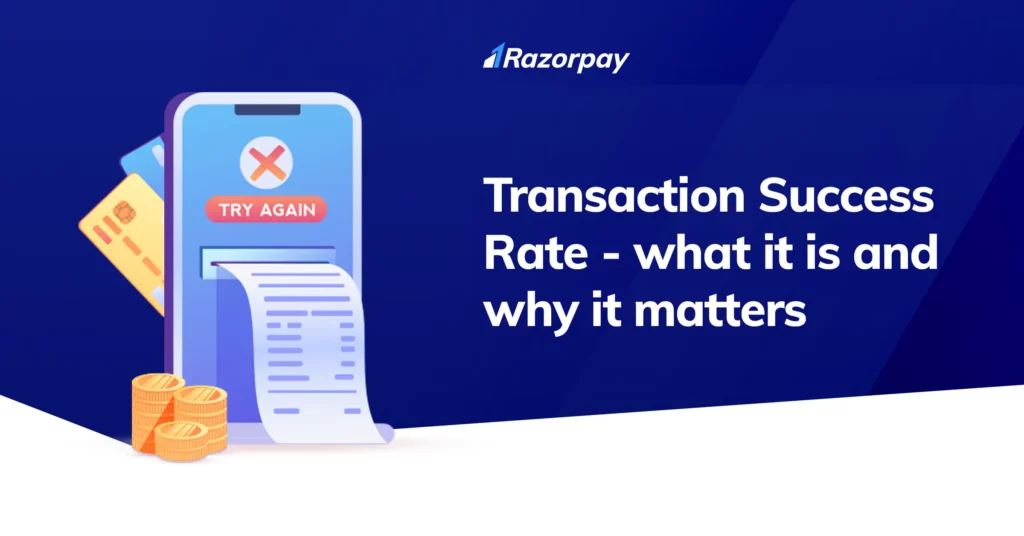In the digital payments world, the metric ‘transaction success rate’ gets used quite often – and with good reason.
Transaction success rates reflect how you get paid, and how smooth that experience is for customers – and low transaction rates can really hurt your business.
In fact, low transaction success rates can cause businesses to lose up to 30% of their earned revenue, and up to 33% of customers facing declined transactions – causing their brand to lose significant value that they had earned.
What is ‘Transaction Success Rate’?
Transaction success rate is the percentage of attempted payments that are successfully completed, and reflects how many payments reached your business for every 100 payments that customers make on your website or your app.
For example, if a hundred payments were attempted and 75 went through, your ‘transaction success rate’ would be 75%. Since payment attempts include customers re-attempting failed payments, this metric is not directly correlated to your revenue.
However, the fact is that 33% of failed payments are not reattempted. Today’s customers want a smooth online payment experience, and every additional step or annoyance on the path from adding to cart to checking out just adds to cart abandonment – and directly impacts a business’ bottom line.
However, unlike other reasons for customers abandoning a cart, payment failure is one of those factors that businesses have little or no control over – and it means that all the cost incurred with acquiring a customer and retaining them gets wasted.
What affects ‘Transaction Success Rate’?
As a measure of the number of payments that succeed, this question can be answered by understanding what causes payment failures. Payment failures can be caused by anything from an incorrectly entered OTP to a delayed response from the payment provider or the bank’s digital infrastructure that is supporting the transaction.
We analysed data from 148 million payments made since December 2020 and here are some insights into what causes transaction failures:
- The main culprits: The 3 most common causes of payment failure that account for ~69% of all failed payments are –
-
-
- Customer took too long to finish payment (38.6%)
- Customer canceled the payment (17.5%)
- Payment processing failure at bank or provider (7.8%)
-
- Is it the customer? Customers account for 67.5% of all failed payments. While some of it is deliberate (cancellation by customer), there are also avoidable cancellations such as insufficient balance in payment method (~4%). There are even some instances of suspicious behaviour – an attempt to transact through a blocked or stolen card, for example (.5%).
- Payments ecosystem: The payments service provider and the issuing bank account for 27.7% of all failed payments. Around 20% of all failed payments are due to transaction errors between the payments provider and various intermediaries in the payments ecosystem, such as –
-
- Card networks (VISA, MasterCard, Rupay, Diner’s Club, American Express)
- Payment enablers (UPI, payment apps, wallets)
- Banks
Why is ‘Transaction Success Rate’ important?
In our increasingly internet-driven world, revenue from digital channels has massively increased in importance. In the last 4 years alone, digital payments have increased by 3.8x from INR 1459 Cr in FY 2017-18 to INR 5554 Cr in FY2020-21. For many customers, the online channel – including payments – is their default mode of consuming goods and services.
These consumers expect a smooth shopping experience – and failed transactions are a big cause for customers churning from a brand. 33% of customers abandon a transaction if it is declined, and 28% of all abandoned carts arise out of payment concerns. If these transactions were to be successful, it could mean an increase in revenue of up to 30% percent for your business! Further, it would also mean other efficiencies – for example, preventing the wastage of costs of acquiring customers who get churned due to such payment failures, and losing the lifetime value they could have given your business.
What can businesses do?
The good news is that business owners can take measures that improve transaction success rate – and this results in higher revenues, greater customer experience, and more value added to their business.
- Make checkout as smooth as possible: The smoother the checkout process, the lower the chance of the user canceling the payment or abandoning the cart. An overly long or laborious checkout process accounts for ~42% of all abandoned carts.
- Payment comes first: Ensure that the shopping cart checkout experience does not require a user to enter too many details before they make their payment. Once that is done, get their address and details – but for a good customer experience, ensure that they need to spend the absolute minimum time and effort to finish buying the products or services they want. Auto-filling city and state from pincode, for instance, can shave a few seconds off the checkout time, and save your business valuable revenue.
- Enable guest checkout: While getting customer information is an invaluable aspect of retention and building a business, making account creation mandatory is a major no-no. 24% of all cart abandonment is attributed to the need to create an account. The best practice here is to enable guest checkout, collect customer email address and phone number as part of the delivery process, and then reach out once they have received the product to get their feedback. An incentive for the next purchase or a nice offer to sweeten the deal also ensures both your business and the customer get what they want.
- Use of saved payment information: Saved payment information can be an absolute blessing for a business. Nobody likes entering 16-digit numbers or UPI IDs repeatedly, and having it appear for a customer just makes it easier for them to buy your products and services and give a business their money. First-time customers can be provided with this checkout experience through a business’ payment provider.
- Exhaustive payment methods: Payments have to be smooth and flexible for a smooth checkout process. Customers get accustomed to payments through their preferred methods, and this can vary from UPI to cards or a particular wallet. Today, the explosive growth in “Buy Now, Pay Later” functionality also means that many customers expect to have the option of paying in EMIs. For a business to ensure customer delight for the largest proportion of their customers, they need to ensure that their payments service provider is ensuring that every potential mode of payment is being provided.
- Smarter routing: Up to 27.7% of all payment failures can be attributed to the payments ecosystem – and these are avoidable. If a business is integrated with multiple payment gateways, then even if one provider is facing some downtime or server issue, the other one can get the job done and ensure that the payment goes through. This dynamic routing to maximize transaction success rate can ensure a 10% uplift in revenue by improving the payments success rate – but integrating with multiple payment providers and building a dynamic routing system is prohibitively expensive.
“Using multiple payments gateways is one of the surest known methods of increasing transaction volumes” – PYMNTS.com
If you want to explore integrating with multiple gateways through Razorpay’s Optimizer, get in touch by writing to us at payments-optimizer@razorpay.com or checking out our product page.


